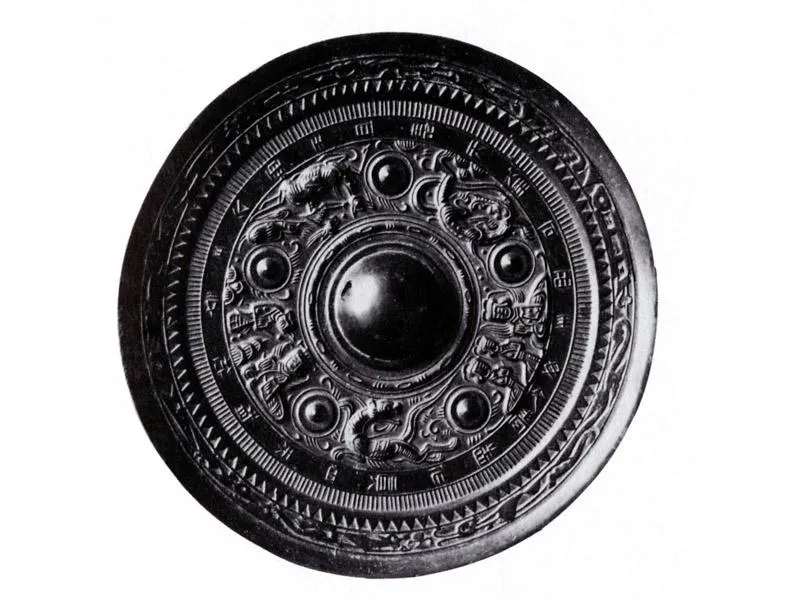Trove of 2,000-Year-Old Bronze Mirrors Found in Ancient Chinese Cemetery
The well-preserved artifacts bear inscriptions such as “Eternal Joy,” “Family Wealth” and “Long Memory”
:focal(400x304:401x305)/https://tf-cmsv2-smithsonianmag-media.s3.amazonaws.com/filer/69/ee/69eef39a-58ad-4e09-ae64-cf24f0904643/bronze_mirror.jpg)
Archaeologists conducting excavations at a cemetery in northwest China have found more than 80 roughly 2,000-year-old bronze mirrors.
Zhu Yingpei, head of the archaeological team at the Dabaozi Cemetery in the Xixian New Area of Shaanxi Province, tells China Global Television Network (CGTN) that ancient humans cast the mirrors using a variety of methods. Ranging in diameter from 3 to 9 inches, many of the artifacts are well preserved. One is still able to reflect images clearly.
Most of the mirrors were buried close to the head or upper body of their owners, who included women and men alike. The accessories held inscriptions conveying wishes for a better life.
State-run news agency Xinhau reports that most of the mirrors date to between the Warring States Period of 475 to 221 B.C. and the late Western Han dynasty, which ended around 9 A.D.
“The newly discovered mirrors are great references for archaeologists to further study the material culture of the early and middle periods of the Western Han Dynasty,” a spokesperson tells the Global Times. “They are also excellent examples of the aesthetic taste of [the] ancient Chinese and possess both historical and artistic value.”
Over 2,000-year-old bronze mirrors unearthed at cemetery in NW China. pic.twitter.com/0blDzKGAc5
— China Perspective (@China_Fact) April 15, 2021
According to Xinhau, the tombs probably belonged to Han elite. Historical records show that the dynasty’s founder, Liu Bang, later known as Gaozu, created a residence for members of the nobility near the cemetery to aid the construction and servicing of the imperial mausoleum.
Born into a peasant family in 256 B.C., Liu Bang became a rebel military leader following the death of Qin Emperor Qin Shi Huang, founder of the first unified Chinese empire. Liu Bang defeated his opponents in a civil war, becoming ruler of China in 202 B.C. and establishing a dynasty that lasted for centuries.
Last year, the Shaanxi Provincial Institute of Archaeology began a major excavation project at the cemetery, as Yang Yimiao Liang Aiping reported for Xinhua at the time. The researchers found almost 300 pieces of pottery, copper, jade and other artifacts, most of which dated to the early Western Han dynasty. The cemetery was divided into multiple areas, possibly organized by family unit, and tombs varied greatly in size and the wealth of artifacts discovered.
Per the Huntington, a library, art museum and botanical garden in California, Chinese manufacturers began working with complex bronze technology as early as 2000 B.C. Mirrors and other bronze items were luxury products used by the elite.

Often cast from clay models, bronze mirrors had a polished side and a reverse decorated in patterns. The earliest of these artifacts included motifs such as birds, dragons and serpents. Later, artisans crafted mirrors featuring deities, mythological figures, abstract patterns and inscriptions. Many contained wishes for good luck. Some mirrors were also inlaid with jade, turquoise and mother-of-pearl.
After the Han dynasty established open trade with the West along the Silk Road in 130 B.C., bronze mirrors began incorporating elements from India, Persia and Egypt, like twisting grapevines, flowers and silver fretwork, according to the Huntington. Per the Metropolitan Museum of Art, mirrors were common grave goods in Han China, as their reflective surfaces were thought “to bring life and light into the darkness of the tomb.”
The History Blog reports that the inscriptions on the newly discovered mirrors include phrases like “Eternal Joy,” “Family Wealth” and “Long Memory,” as well as geometric and floral motifs.
Zhu tells CGTN that the mirrors will help researchers learn more about the development of bronze mirrors and the lives of local people during the Qin and Han dynasties.
/https://tf-cmsv2-smithsonianmag-media.s3.amazonaws.com/accounts/headshot/Livia_lg_thumbnail.png)
/https://tf-cmsv2-smithsonianmag-media.s3.amazonaws.com/accounts/headshot/Livia_lg_thumbnail.png)